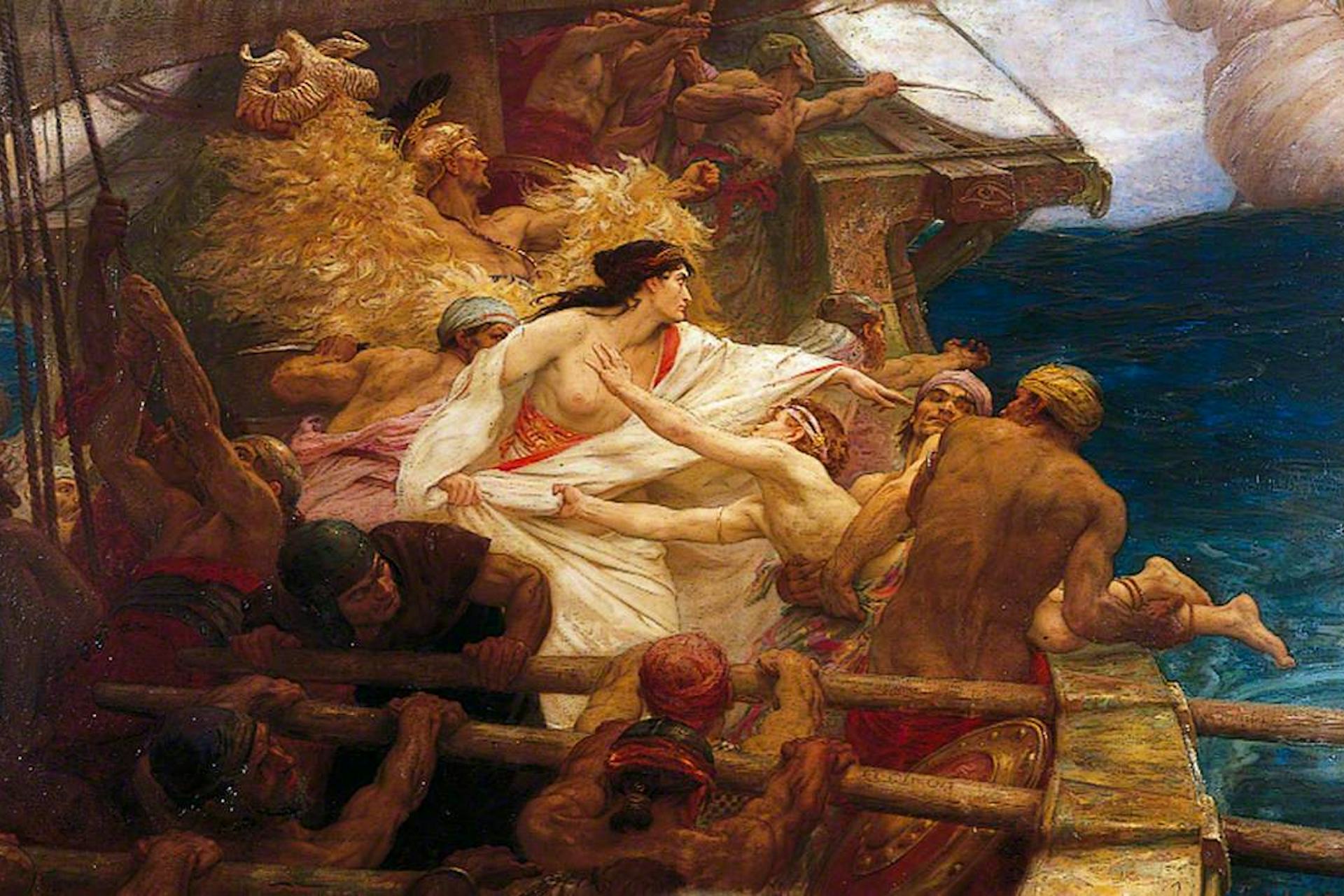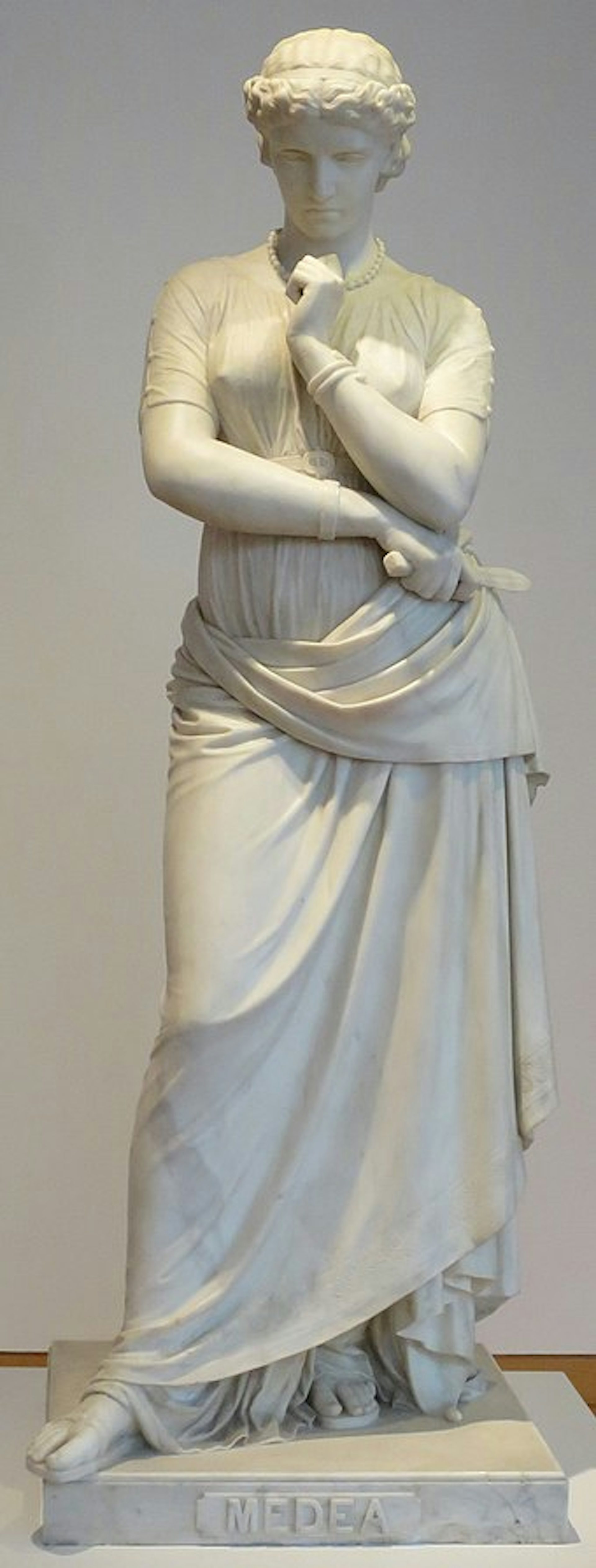Apsyrtus

The Golden Fleece by Herbert James Draper (1904)
Bradford Museums and GalleriesCC BY-NC-ND 4.0Overview
Apsyrtus was the son of King Aeetes of Colchis and the brother of the witch Medea. He met his end when the Argonauts, led by the hero Jason, came to Colchis to carry away the Golden Fleece.
After Medea helped Jason and the Argonauts flee Colchis with the fleece, she killed Apsyrtus to distract her father from pursuing them—either by ambushing him on a remote island or by cutting him up into pieces and throwing them into the sea.
Etymology
The etymology of the name “Apsyrtus” (Greek Ἄψυρτος, translit. Ápsyrtos) is unknown. In antiquity, the name was often linked to the Apsyrtides Islands, located just off the Illyrian coast of the Adriatic Sea; it was often said that these islands got their name from the mythical Apsyrtus.[1]
Other etymologies have also been proposed, including one that links Apsyrtus’ name to Abchasia in the Caucasus (the region where the mythical Apsyrtus was said to have come from).[2]
Pronunciation
English
Greek
Apsyrtus Ἄψυρτος (Ápsyrtos) Phonetic
IPA
[ap-SUR-tuhs] /æpˈsɜr təs/
Alternate Names and Epithets
According to some sources, Aeetes’ son was named Aegialeus[3] or Metapontius[4] rather than Apsyrtus. Roman authors generally agreed with the standard name, Apsyrtus, but spelled it “Absyrtus” in Latin.
Apollonius of Rhodes reported that Apsyrtus was also called Phaethon, “the shining one,” because “he outshone all the youths.”[5]
Attributes
Apsyrtus was the prince and heir apparent of Colchis, a region on the eastern coast of the Black Sea. He lived in the palace of his father, King Aeetes, whose city was called Aea.
Accounts of Apsyrtus’ mythology differed widely in antiquity. According to some traditions, Apsyrtus was still a child when he was killed by Medea and Jason (see below). But in other traditions, Apsyrtus had already grown into a strong young man when the Argonauts came to Colchis.
Apollonius of Rhodes says that Apsyrtus was a warrior and the charioteer of his father Aeetes,[6] while Valerius Flaccus depicts him as a strong fighter who inspired fear when he entered battle against the forces of his father’s enemy, Perses:
Absyrtus, amid the effulgence of his flashing shield and of the chariot of his grandsire the Sun (whose quivering spear and threatening helm the folk could not look on close at hand, but in fear gave ground and turning their backs were stricken, while their loud cries enhance the panic)—he with the impact of galloping steeds lays warriors low, and tramples the groans of the living mass.[7]
Apsyrtus was not a popular subject among ancient artists. In fact, there are no known representations of him in Greek or Roman art.[8]
Family
Apsyrtus’ father was Aeetes, the son of Helios. His mother’s identity is less certain. In one tradition, she was the Oceanid Idyia, said in most sources to have been Aeetes’ wife.[9] But according to Apollonius of Rhodes, Apsyrtus was the son of Asterodia, Aeetes’ previous wife before he married Idyia.[10]
Others said that Apsyrtus’ mother was a Nereid (possibly named Neaera);[11] Hecate (a mortal witch, not the more familiar Underworld goddess);[12] or Hypsea.[13] In another important early source, Aeetes’ wife—and thus possibly Apsyrtus’ mother—was called Eurylyte.[14]

Medea by William Wetmore Story (1866)
High Museum of Art, Atlanta, GA / WmpearlCC0Apsyrtus had at least two sisters (or half-sisters). In the common tradition, these were Calchiope, who married Phrixus (a prince who arrived in Colchis on the back of a golden ram); and the witch Medea, who ran off with Jason when he came to Colchis for the Golden Fleece.[15] One author added another sister named Circe.[16]
Mythology
Apsyrtus and the Argonauts
In most accounts, Apsyrtus’ only mythical role was as a casualty in Jason’s expedition for the Golden Fleece (though in one source, he also helped his father Aeetes defeat Perses—Aeetes’ brother—when he tried to steal the throne of Colchis).[17]
Jason had been sent by his uncle Pelias to fetch the famous Golden Fleece, which was owned by Aeetes. Jason fitted an impressive ship, assembled a team of heroes (known as the Argonauts), and sailed to Colchis to fulfill his mission.
But Aeetes was unwilling to part with the Golden Fleece. Jason underwent several trials to try and win the fleece from Aeetes, but in the end he ultimately stole it with the help of Aeetes’ daughter Medea, who had fallen in love with him. Jason, Medea, and the Argonauts then fled from Colchis on their ship, the Argo.
Virtually all traditions seem to agree that Apsyrtus was killed at some point during Aeetes’ pursuit of the Argonauts, though there are several different versions of how, when, and where.
In what may have been the earliest version of the myth, Apsyrtus was killed in Aeetes’ palace, before Jason and the Argonauts had even left Colchis. Unfortunately, this version is known only from fragmentary sources, so the details of Apsyrtus’ death are hazy.[18]
In another early version of the myth, Medea abducted her brother Apsyrtus—still a child at the time—as she was escaping from Colchis with the Argonauts. When Aeetes sent his army after the Argo, Medea killed and dismembered the young Apsyrtus. She then threw the pieces of his body into the sea to distract their pursuers. The Colchians stopped to collect the pieces, thus buying the Argonauts time to get away.[19]

The Golden Fleece by Herbert James Draper (1904).
Bradford Museums and GalleriesCC BY-NC-ND 2.0In yet another account, Apsyrtus was actually the one who led the Colchian army in pursuit of the Argonauts. According to Apollonius of Rhodes, Medea used her cunning to lure him to a remote island near the mouth of the Danube River: she sent him a message saying that she would meet him with the Golden Fleece, and that the two of them would then return to their father in Colchis.
But when Apsyrtus came, Jason—who was lying in ambush near a temple of Artemis—snuck up on him and killed him.[20] A later source, the Roman poet Valerius Flaccus, tells a similar story in which Jason killed Apsyrtus and his men in battle by the mouth of the Danube.[21]
Later sources knew of several other variations on the myth of Apsyrtus’ death. Hyginus, for instance, recounts a version in which the murder did not take place until the end of the Argonauts’ journey, after they had left the island of the Phaeacians. This would mean that Apsyrtus was killed off the coast of Illyria on the Adriatic Sea, not near the mouth of the Danube.[22]
The Tomb of Apsyrtus
Because there were different versions of Apsyrtus’ death, there were also different traditions regarding the location of his tomb. Some said that he was buried in Tomis, a city on the coast of the Black Sea, which supposedly derived its name from the Greek word meaning “to cut” (so named because Medea killed Apsyrtus by cutting him into pieces).[23]
But other authorities (presumably those who thought he died near Illyria) said that Apsyrtus’ body washed ashore on the Apsyrtides Islands, and that his tomb was located there.[24]
Popular Culture
Apsyrtus still occasionally appears in modern adaptations of the myth of the Argonauts. He is featured in Robert Graves’ novel Hercules, My Shipmate (1944) and Henry Treece’s Jason (1961), both of which retell the myth of the Argonauts from a historicizing angle.
Apsyrtus has also appeared in film and television, including the 2000 miniseries Jason and the Argonauts, where he is played by James Callis. Surprisingly, the 1963 cult classic Jason and the Argonauts omits Apsyrtus’ brutal demise.